Private First Class Johnnie Harrison Bailey
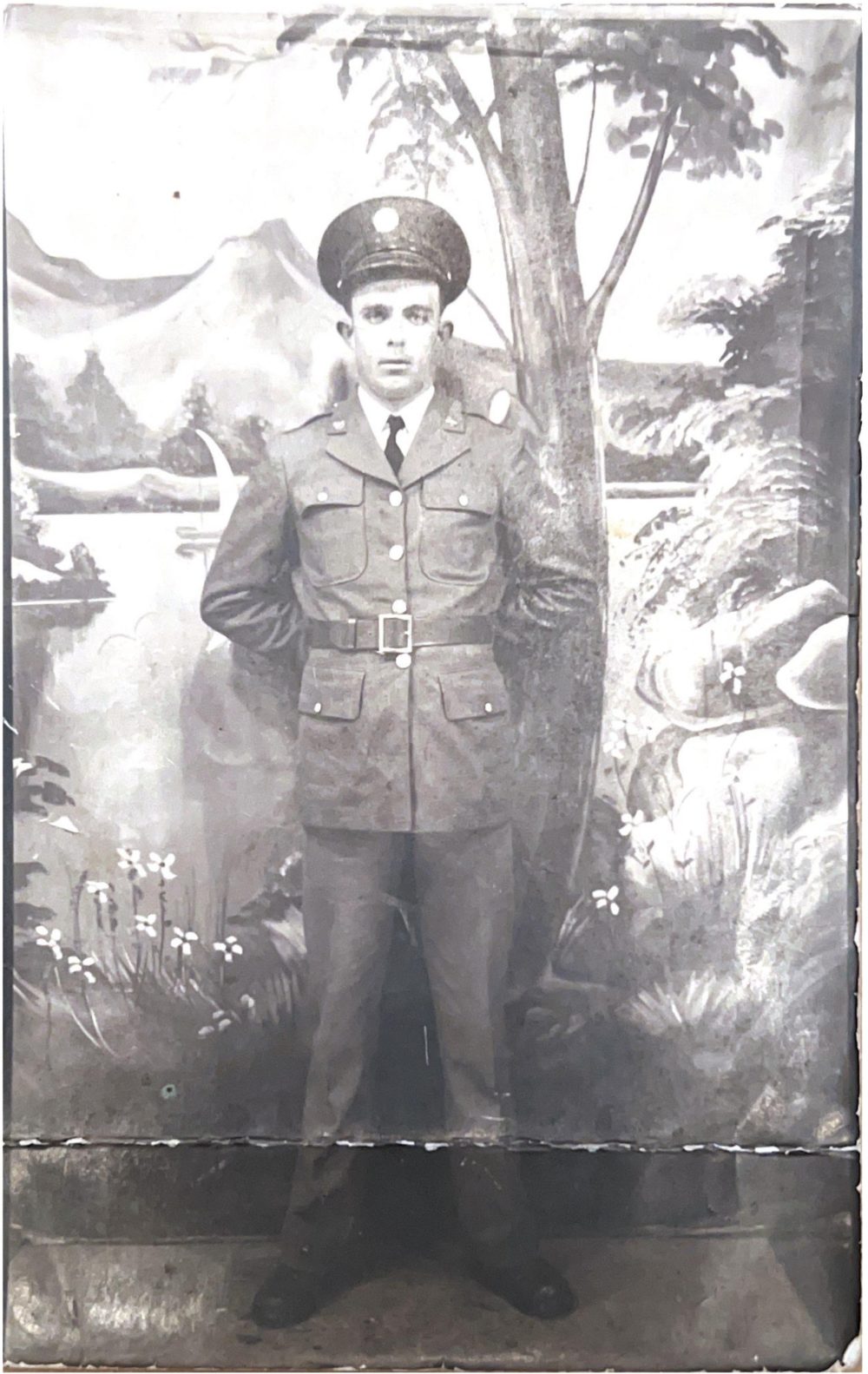
- Unit: 27th Infantry Division, 105th Infantry Regiment, Company M
- Service Number: 34148904
- Date of Birth: December 12, 1917
- Entered the Military: November 8, 1941
- Date of Death: April 10, 1945
- Hometown: Beech Springs, Tennessee
- Place of Death: Tsuken (Tsugen) Island, Ryukyu Islands
- Award(s): Purple Heart with Oak Leaf Cluster, Bronze Star
Mentored by Ms. Rebecca Byrd
Sevier County High School
2022/2023
Early Life
Johnnie Harrison Bailey was born on December 12, 1917, to John and Georgia Bailey in the Beech Springs area of Sevier County, Tennessee. He was a younger brother to Fred, Mae, Ray, and Anna Ruth and an older brother to Charlie Robert, Roy, Bert, Beatrice, Jay “J.R.”, Coy, and Gladys. He and his siblings helped their father raise hogs, grow tobacco, and garden. The Bailey family attended the French Broad Valley Baptist Church, located about two miles from the family farm each Sunday.
Johnnie attended the one-room Douglas Schoolhouse from first through sixth grade. At 13, during the height of the Great Depression, he left school to help his father on the farm. Bailey and his father traveled to Knoxville to sell meat under the name “J.H. Bailey Pure Pork Company.” Johnnie never attended high school or college. In 1940, 23-year-old Johnnie left home to enlist in the United States military.
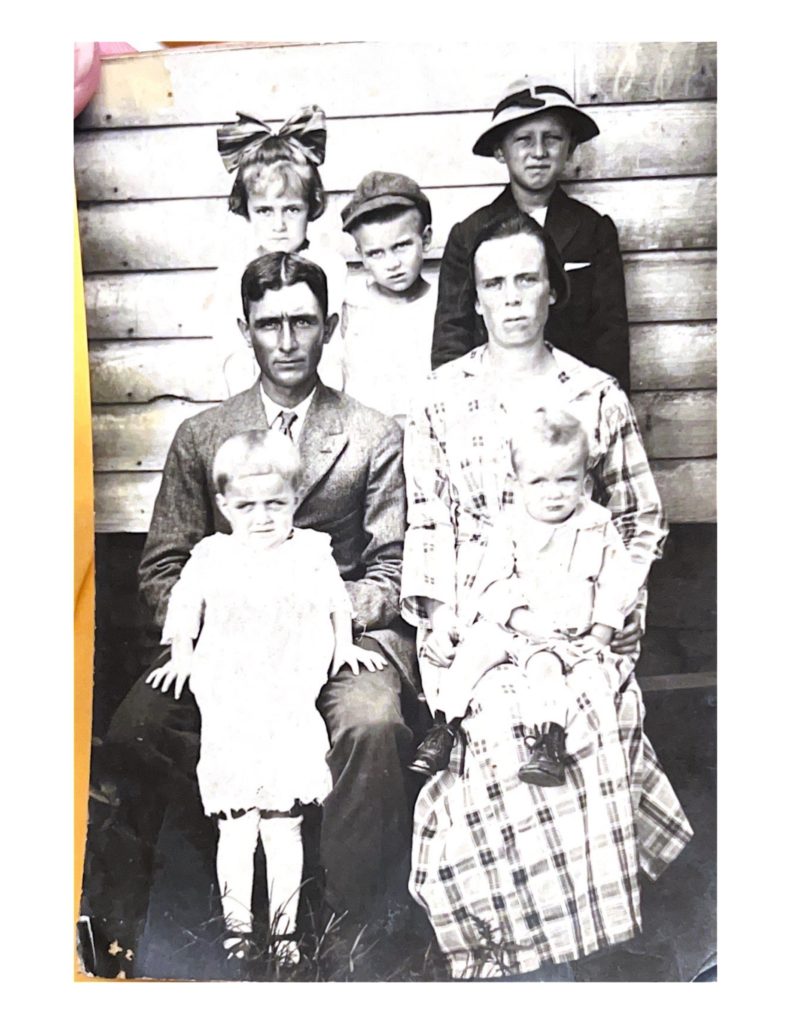

Homefront
By 1940, the New Deal had begun transforming life in East Tennessee. Norris Dam, the first to be completed by the Tennessee Valley Authority (TVA), made low-cost electricity a reality for many East Tennesseans, however, it also forced many families off of farmland they had tilled for generations. In Sevier County, the creation of the Great Smoky Mountains National Park in 1934 also led to the displacement of many families. When Bailey left home in 1940, mountain farms were being transformed by the efforts of the Civilian Conservation Corps.
The United States’ entry into World War II quickly changed the lives of many families in Sevier County as young men were either drafted or enlisted. The class photographs of Sevier County High School reflect this reality. The Class of 1944 had 52 graduates, but only 10 men.
In March 1942, TVA began constructing Douglas Dam along the French Broad River in Sevier County, Tennessee. Douglas Dam, like Norris, displaced numerous families but was justified as necessary to generate electricity to aid the war effort. Electricity from Douglas Dam was used in aluminum production by the Aluminum Corporation of America in neighboring Blount County and for a secret government facility in Roane County known as Clinton Engineering Works.
In 1942, the government began acquiring land in Roane County for a top-secret facility as part of the Manhattan Project. This facility enriched the uranium used in the atomic bombs. Many women from Sevier County found jobs during the war in the “secret city.” Still, they would not discover the purpose of their work until August 1945, when the first atomic bomb was dropped on Hiroshima.
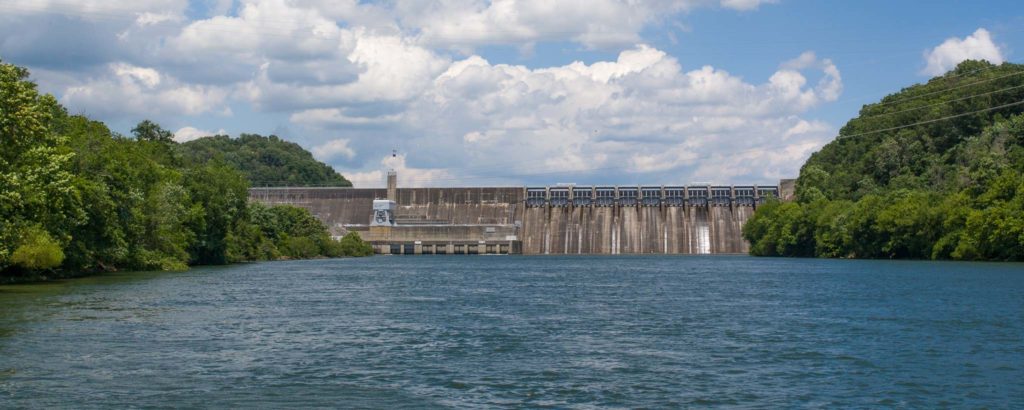

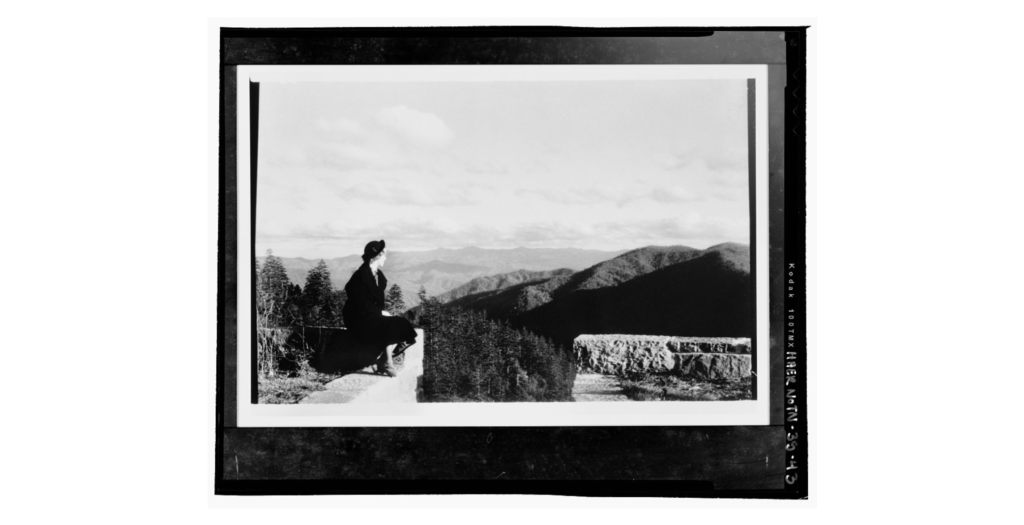
Military Experience
Bailey’s military service began on November 8, 1941, when he enlisted into the United States Army in Fort Oglethorpe, Georgia. His family recalled that Johnnie joined the Army so he could send money home to help his family.
Upon completing Basic Training, Private First Class Bailey was assigned to the 27th Infantry Division, 105th Infantry Regiment, Company M.
In early 1943, Private First Class Bailey and the 105th Infantry Regiment received tropical warfare combat training in Hawaiʻi, including storming beaches. Bailey sent souvenirs from Hawaiʻi such as a grass hula skirt for his niece and a drinking glass with a picture of a hula girl for his family.
The 27th Infantry Division then moved to New Zealand, where the United States had many training camps. In November 1943 while in New Zealand, Private First Class Bailey was wounded by an artillery shell. Admitted to a hospital aid station, the wound to his left hand was treated. After being discharged, Bailey returned to his company.
Bailey and his company were later involved in the attempt to capture the sea-plane landing strip on Makin Island, just south of the Marshall Islands, where the rest of the 105th Infantry Division was located. These islands, being located centrally in the Pacific, were critical to the American island-hopping strategy. This landing strip allowed planes to land safely and refuel before reaching their final destination.
Throughout his military service, Bailey periodically sent “V-Mail” home to his parents and siblings, speaking of the wild journeys he and his comrades experienced. In one of his letters, he said that his company was on a ship and was unsure of the destination. He hoped it was home. Instead of home, Private First Class Bailey and the 27th Infantry Division headed to Okinawa, the last step in the island-hopping strategy leading to the Japanese home islands.
Private First Class Bailey was wounded on April 10, 1945, while taking part in the invasion of Tsuken Island off the coast of Okinawa. He suffered a penetrating gunshot wound to the abdomen and was admitted to a hospital aid station where he received a blood transfusion, However, he was unable to overcome his injury and died.
Bailey was one of the 49,000 American casualties of the invasion of Okinawa. Total fatalities, including Japanese military and civilians, were estimated at 240,000, making Okinawa the deadliest battle of the Pacific Theater.
Due to these massive numbers, President Harry S. Truman and top military officials reconsidered the invasion of the home islands planned for the fall of 1945. Instead, Truman decided to use the top-secret atomic bomb that was successfully tested on July 16, 1945. Little Boy, the atomic bomb dropped on Hiroshima on August 6, 1945, used uranium enriched in the secret city of Oak Ridge, Tennessee, just miles from Private First Class Bailey’s hometown.
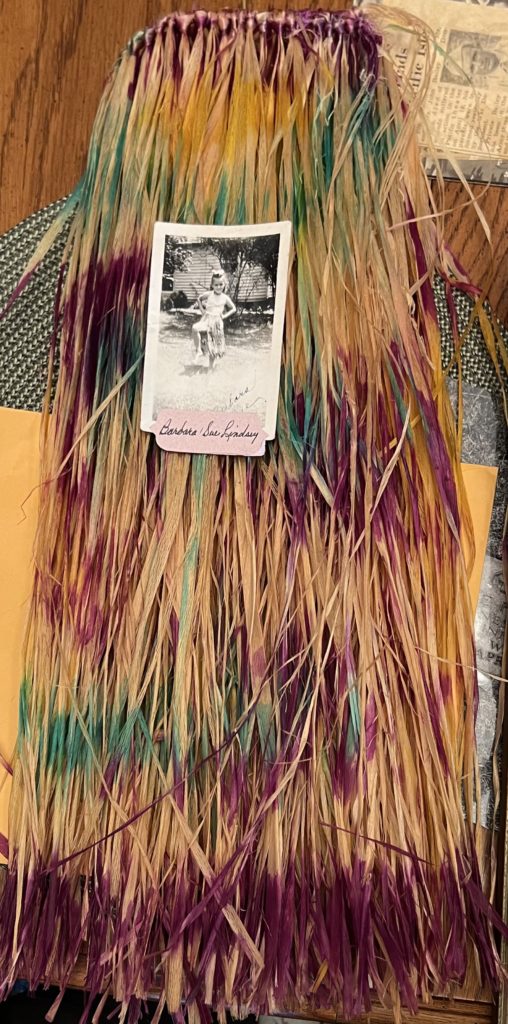
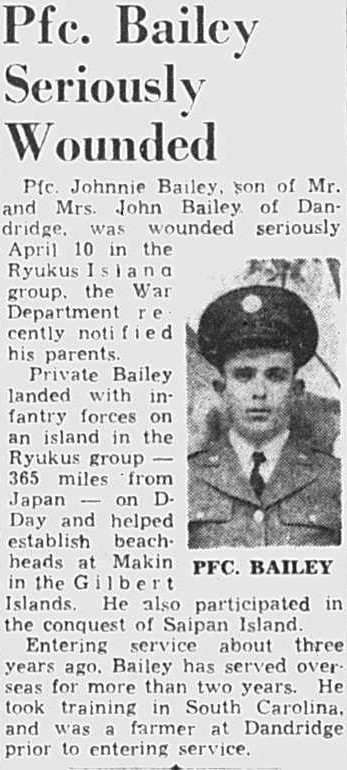
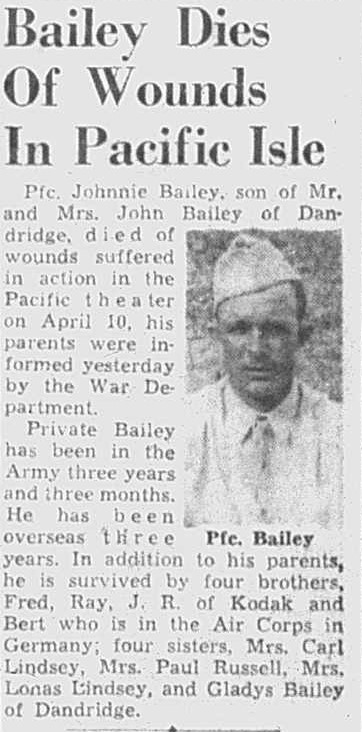
Eulogy
After his death, Private First Class Bailey’s remains were not immediately returned to the United States. Instead, his body was temporarily buried in the Tsuken Jima Cemetery. In December 1945, his body was re-interred at the Okinawa Island Cemetery on Ryukyu Retto, Okinawa. In January 1946, the family received Private First Class Bailey’s personal items.
Mrs. Georgia Bailey wrote to the Army Effects Bureau she had not received a watch that she sent her son just months before his death or the photographs he always carried in his wallet, her grief evident in every word. The Army Effects Bureau had no answers for her. Eventually, in 1949 his body was re-interred at the National Memorial Cemetery of the Pacific in Honolulu, where he had trained for tropical warfare six years prior. When asked where Private First Class Bailey’s final resting place should be, his parents chose the National Memorial Cemetery of the Pacific. They also asked for the slogan, “Our beloved Son, gone, but never forgotten.” to appear on his headstone. Unfortunately, the Army was unable to inscribe this on his headstone due to size limitations, but all felt their heartfelt grief.
Private First Class Bailey’s family had a headstone placed at Underwood Cemetery in the Beech Springs area of Sevier County, miles from the family farm, where they could gather to remember him and honor his service and sacrifice.
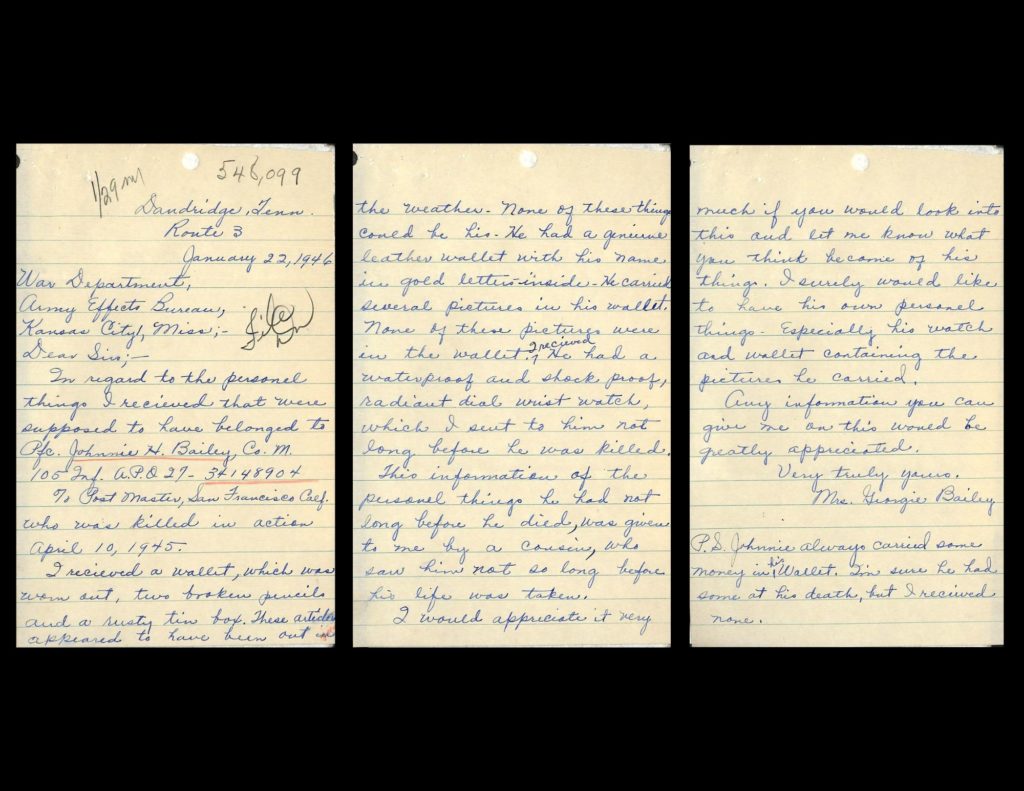
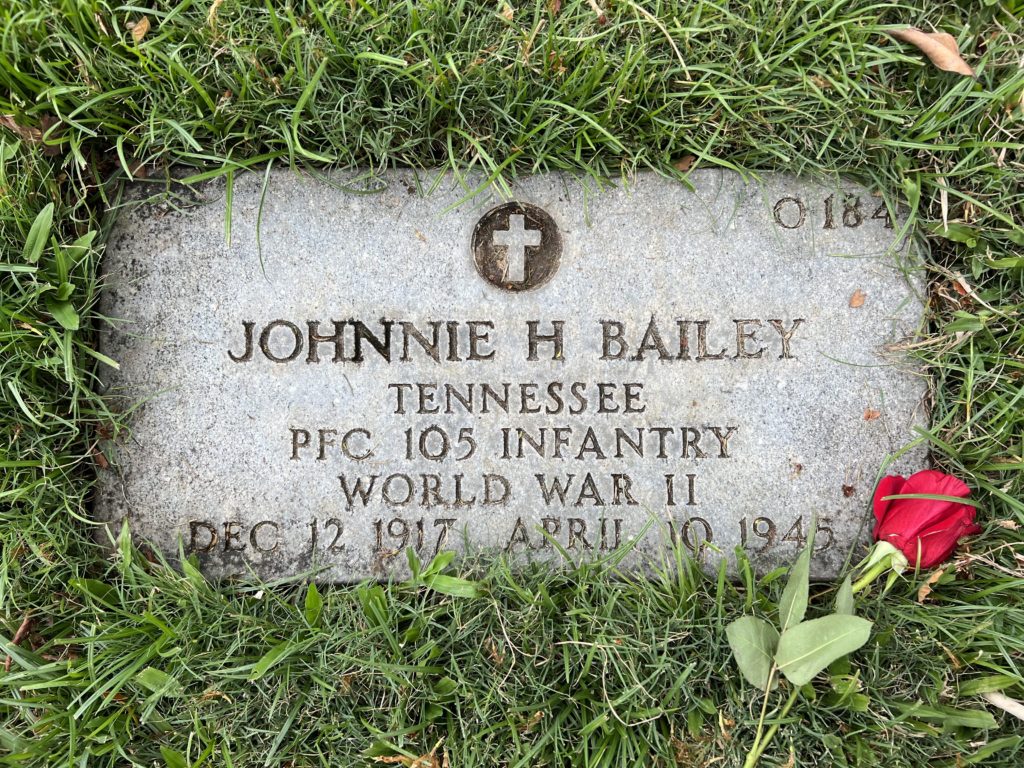
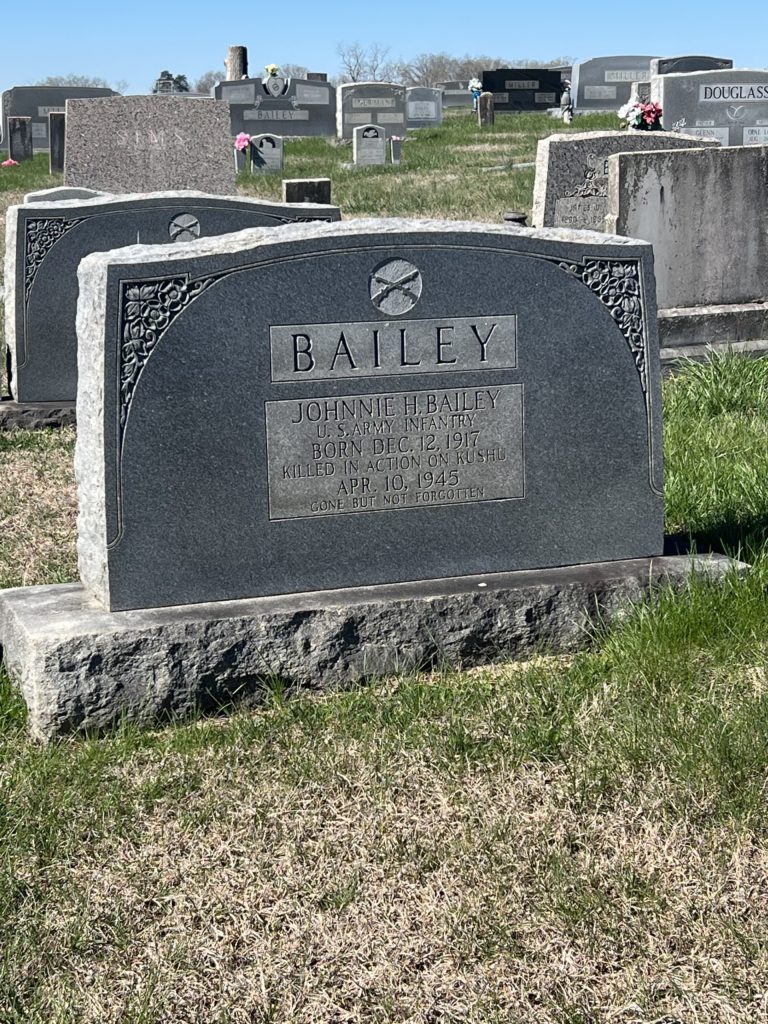
Reflection
The Sacrifice for Freedom®: World War II in the Pacific Student and Teacher Institute was a life-changing experience. I learned so much about the causes of the war and the major battles of the Pacific theater during the months leading up to what I thought would be a “fun history trip.”
On the USS Arizona Memorial, my view of the trip quickly changed. While standing on the memorial looking over the side and seeing the sunken ship below me, it finally hit me that there were almost 1,000 men below me. Furthermore, because of those men and their sacrifice, I had the freedom to be on a trip like I was and I had the privilege to drop a flower in the water to thank them. After visiting the Arizona Memorial, we visited the USS Missouri where I could “live like a sailor.” Being able to play a role in the lowering and folding of the flag that night brought back so many memories of veteran’s funerals I had attended. To think that I had the opportunity to fold the flag that flies atop the ship that the Japanese surrender documents from World War II were signed on was life-changing. I never dreamed that I, a history-loving girl from Tennessee, would have an experience even close to that.
The following day, I was shown a picture taken on December 7, 1941, featuring a torpedo in the water headed for the exact location I was standing. That is one moment in my life that I can truly say I was speechless. Then, we visited the Japanese Cultural Center where I met several third-generation Japanese-Americans who told their family’s story of World War II. Hearing their connections to these tragedies brought a new perspective to light, and that was very meaningful to me.
In all, I have learned that history always has multiple perspectives. When you see something it means so much more than reading about it, and each person we see on a memorial wall or in a veteran’s cemetery has a story. Sharing Private First Class Bailey’s story with my school and community has allowed me to speak for one of the names on the long list of soldiers who gave the ultimate sacrifice.
Bibliography
Primary Sources
“Bailey Dies of Wounds in Pacific Isle.” Bailey Family Records, 1930-1945. Courtesy of Johnny Cheek, Juanita Heard, and Barbara Suttles.
Bailey Family Photographs. 1917–1950. Courtesy of Johnny Cheek, Juanita Heard, and Barbara Suttles.
Bailey Family Records. 1917–1950. Courtesy of Johnny Cheek, Juanita Heard, and Barbara Suttles.
Escott, Ed. The Alpha Track Calutron at the Y-12 Plant in Oak Ridge used an electromagnetic separation process to enrich uranium. Photograph. C.1944-1945. U.S. Department of Energy. https://wpln.org/post/how-the-u-s-created-a-secret-city-in-oak-ridge-to-build-the-atomic-bomb-75-years-ago/#stream/0.
Hass, David W. Great Smoky Mountains National Park Roads & Bridges, Gatlinburg, Sevier County, TN. Photograph. C.1930s. Library of Congress (tn0275). https://www.loc.gov/item/tn0275/.
Johnnie H. Bailey. Final Pay Voucher. National Archives and Records Administration – St. Louis.
Johnnie H. Bailey. Individual Deceased Personnel File, Department of the Army. National Archives and Records Administration – St. Louis.
Johnnie H. Bailey. World War II Army Enlistment Records, 1938-1946. https://ancestry.com.
Johnnie H. Bailey. World War II Draft Cards Young Men, 1940-1947. Digital images. https://ancestry.com.
Johnnie H. Bailey. World War II Hospital Admission Card Files, 1942-1954. https://ancestry.com.
“PFC Bailey Seriously Wounded.” Bailey Family Records. 1930-1945. Courtesy of Johnny Cheek, Juanita Heard, and Barbara Suttles.
Tennessee. Sevier County. 1930 U.S. Census. Digital images. https://ancestry.com.
Tennessee. Sevier County. 1940 U.S. Census. Digital images. https://ancestry.com.
Secondary Sources
“105th Infantry Regiment.” New York State Military Museum and Veterans Research Center. Accessed May 19, 2023. https://museum.dmna.ny.gov/unit-history/conflict/world-war-2-1939-1945/105th-infantry-regiment.
Anderson, Charles R. Western Pacific: 15 June 1944–2 September 1945. Washington, D.C.: U.S. Army Center of Military History, 2021. Accessed August 21, 2023. https://history.army.mil/brochures/westpac/westpac.htm.
Brake, Patricia. “World War II.” Tennessee Encyclopedia. Last modified March 1, 2018. Accessed April 4, 2023. https://tennesseeencyclopedia.net/entries/world-war-ii/.
Byrd, Rebecca. “Supporting and Tempering Distant Forces: The World War II Experience of Chestnut Hill, Tennessee.” The Journal of East Tennessee History 85 (2013): 70-89.
“The Camps.” New Zealand History. Last modified June 12, 2023. Accessed August 12, 2023. https://nzhistory.govt.nz/war/us-forces-in-new-zealand/the-camps
Cheek, Johnny. Personal interview with the author. February 13, 2023.
“The Great Depression and World War II.” Tennessee 4 Me. Accessed April 4, 2023. https://www.tn4me.org/minor_cat.cfm?minor_id=71&major_id=9&era_id=7.
Heard, Juanita. Personal interview with the author. February 13, 2023.
Heard, Juanita. Personal interview with the author. March 15, 2023.
Hooper, Ed. Images of America: Knoxville in World War II. Arcadia Publishing, 2006.
“Johnnie H. Bailey.” East Tennessee Veterans Memorial Association. Last modified January 21, 2010. Accessed May 19, 2023. https://etvma.org/veterans/johnnie-h-bailey-10450/.
“Johnnie H. Bailey.” National Cemetery Administration. Accessed March 12, 2023. https://gravelocator.cem.va.gov/ngl/result#results-content.
Mills, Kim. “The Volunteer State Goes to War: A Salute to Tennessee Veterans.” Tennessee State Library and Archives. Accessed April 4, 2023. https://sharetngov.tnsosfiles.com/tsla/exhibits/veterans/ww2.htm.
Newell, Lt. Col. Clayton R. Central Pacific. Washington, D.C.: U.S. Army Center of Military History, 2019. https://history.army.mil/brochures/72-4/72-4.HTM.
Spiner, Emily. “How the U.S. Created a ‘Secret City’ in Oak Ridge to Build the Atomic Bomb, 75 Years Ago.” Nashville Public Radio. Last modified September 20, 2017. Accessed August 21, 2023. https://wpln.org/post/how-the-u-s-created-a-secret-city-in-oak-ridge-to-build-the-atomic-bomb-75-years-ago/.
Suttles, Barbara. Personal interview with the author. February 13, 2023.
“What Democracy Can Do.” Tennessee Valley Authority. Accessed April 13, 2023. https://www.tva.com/About-TVA/Our-History/Built-for-the-People/What-Democracy-Can-Do.


